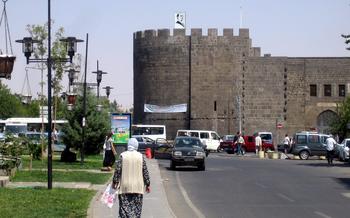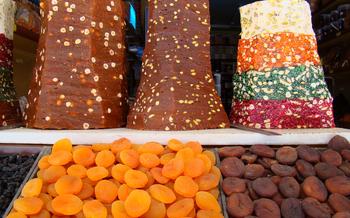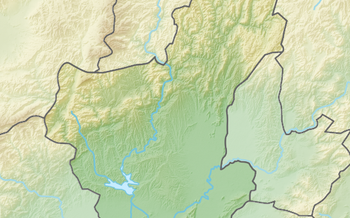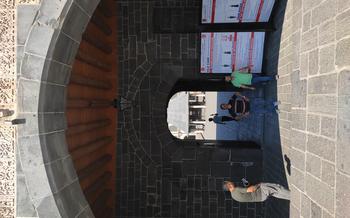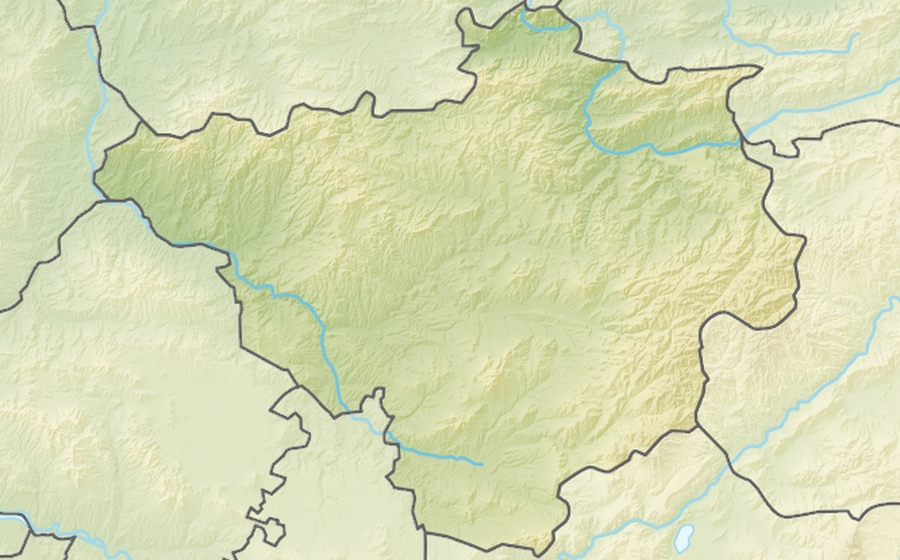
Yozgat Çapanoğlu Büyük Camii (Yozgat Çapanoğlu Grand Mosque)
- Yozgat Çapanoğlu Büyük Camii: A Legacy of Architectural Excellence
- Unveiling the History of Yozgat Çapanoğlu Büyük Camii
- Exploring the Architectural Marvels of the Mosque
- A Journey Through the Centuries: The Evolution of Yozgat Çapanoğlu Büyük Camii
- The Grand Entrance: Awe-Inspiring First Impressions
- The Domed Roof: A Symbol of Grandeur
- Intricate Stonework and Carvings: A Tapestry of Artisanship
- Symmetry and Balance in Design: A Reflection of Harmony
- Visiting Yozgat Çapanoğlu Büyük Camii: Practical Information
- Local Customs and Traditions: Respecting the Culture
- Insider Tip: Unveiling the Hidden Gem of Yozgat
Yozgat Çapanoğlu Büyük Camii: A Legacy of Architectural Excellence
The Yozgat Çapanoğlu Büyük Camii stands as a testament to the rich architectural heritage of Turkey. Its historical significance is deeply rooted in the 14th century, when it was commissioned by the Çapanoğlu family, a prominent dynasty that ruled the region. The mosque's distinctive features, including its impressive dome structure, intricate stonework, and harmonious symmetry, reflect the architectural prowess of the Seljuk period. Beyond its aesthetic beauty, the Yozgat Çapanoğlu Büyük Camii holds cultural and religious importance, serving as a place of worship, a center for community gatherings, and a symbol of Islamic faith in the region.
Unveiling the History of Yozgat Çapanoğlu Büyük Camii
The Yozgat Çapanoğlu Büyük Camii stands as a testament to the rich history of Yozgat and the enduring legacy of the Çapanoğlu family. Its construction dates back to the 14th century, during the reign of the Beylik of Çapanoğulları. The Çapanoğlu family, known for their patronage of the arts and architecture, commissioned the construction of the mosque as a symbol of their power and influence in the region.
Historical accounts suggest that the mosque was built on the site of an earlier Byzantine church, reflecting the diverse cultural influences that have shaped the history of Yozgat. The construction of the mosque was overseen by skilled architects and craftsmen who employed traditional Seljuk architectural techniques and incorporated intricate stone carvings and decorative elements into the design.
Exploring the Architectural Marvels of the Mosque
The Yozgat Çapanoğlu Büyük Camii boasts several architectural marvels that reflect the skill and artistry of its builders. The most striking feature is its unique dome structure, which differs from the traditional domes of other mosques. Instead, it resembles an inverted pyramid, with a series of steps leading to a central point. This unique design adds to the mosque's visual appeal and reflects the innovative architectural thinking of the time.
The mosque's exterior is adorned with intricate stonework and carvings, showcasing the remarkable craftsmanship of the artisans involved in its construction. Floral motifs, geometric patterns, and verses from the Quran are delicately carved into the stone, creating a tapestry of artistic beauty. These carvings not only enhance the mosque's aesthetic appeal but also carry cultural and symbolic significance, reflecting the Islamic heritage and traditions of the region.
The mosque's overall design exhibits a remarkable sense of symmetry and balance. The central dome is flanked by two smaller domes, and the four corners of the building are marked by four minarets, creating a harmonious and visually pleasing composition. This symmetry reflects the architectural principles of the Seljuk dynasty, which emphasized order, harmony, and proportion in their buildings.
A Journey Through the Centuries: The Evolution of Yozgat Çapanoğlu Büyük Camii
The Yozgat Çapanoğlu Büyük Camii has undergone several renovations and restorations throughout its history, adapting to changing times while preserving its historical essence. The mosque's original construction in the 14th century showcased the architectural prowess of the Seljuk dynasty. Over the centuries, it has undergone various modifications and additions, reflecting the evolving needs and tastes of the community.
During the Ottoman period, the mosque underwent significant renovations, including the addition of a new minaret and the expansion of the prayer hall. These changes reflected the growing importance of the mosque as a religious and cultural center in the region.
In the 20th century, the mosque underwent further restoration efforts to preserve its historical integrity and architectural beauty. These renovations included the repair of damaged stonework, the restoration of intricate carvings, and the replacement of worn-out elements with materials that matched the original design.
Despite these changes, the Yozgat Çapanoğlu Büyük Camii has retained its original character and continues to serve as a living testament to the rich architectural heritage of Turkey. It stands as a symbol of continuity and resilience, having gracefully adapted to the passage of time while preserving its historical and cultural significance.
The Grand Entrance: Awe-Inspiring First Impressions
The grand entrance of Yozgat Çapanoğlu Büyük Camii serves as a captivating introduction to the architectural wonders that lie within. A majestic portal, adorned with intricate carvings and decorative elements, welcomes visitors into a sacred space. The doorway is flanked by towering minarets, emphasizing the mosque's verticality and reaching for the heavens.
Above the entrance, a series of inscriptions in elegant calligraphy provide a glimpse into the mosque's history and significance. These inscriptions often contain verses from the Quran, the Islamic holy book, or poetic expressions extolling the virtues of faith and devotion.
The entrance to the mosque is not merely a physical threshold but a symbolic one, inviting visitors to leave behind the distractions of the outside world and enter a realm of spirituality and contemplation. The grandeur of the entrance sets the tone for the awe-inspiring experience that awaits within the mosque's sacred halls.
The Domed Roof: A Symbol of Grandeur
The domed roof of the Yozgat Çapanoğlu Büyük Camii is a striking feature that dominates the skyline and adds to the mosque's majestic presence. Constructed using traditional techniques, the dome stands as a testament to the architectural prowess of the Seljuk era. Its size and shape contribute to the overall grandeur of the mosque, creating a sense of awe and reverence among visitors. The dome's structural integrity ensures its resilience against the elements, symbolizing the endurance and permanence of faith.
Aesthetics and symbolism play a significant role in the design of the dome. Its intricate patterns and motifs reflect the cultural and artistic heritage of the Seljuk dynasty. The dome's upward curve represents the connection between the earthly realm and the heavens, symbolizing the aspiration towards spiritual transcendence. It serves as a reminder of the divine presence and the ultimate goal of achieving closeness to God.
The domed roof of the Yozgat Çapanoğlu Büyük Camii is not just an architectural marvel but also a powerful symbol of faith and devotion. Its grandeur and symbolism inspire visitors to reflect on the majesty of the divine and the pursuit of spiritual enlightenment.
Intricate Stonework and Carvings: A Tapestry of Artisanship
The Yozgat Çapanoğlu Büyük Camii is adorned with intricate stonework and carvings that showcase the exceptional craftsmanship of its builders. These decorative elements are not merely aesthetic embellishments; they hold deep symbolic and cultural significance. The motifs and patterns depicted in the stonework draw inspiration from Islamic art and tradition, representing various aspects of faith, nature, and the cosmos.
The artisans who meticulously carved these intricate designs demonstrated their mastery of the craft. The precision and attention to detail are evident in every element, from the delicate floral patterns to the intricate geometric shapes. These carvings serve as a testament to the skill and dedication of the craftsmen who dedicated their time and effort to creating a truly awe-inspiring masterpiece.
Each motif and symbol holds a special meaning, adding depth and richness to the mosque's overall aesthetic. From verses from the Quran to representations of paradise, these carvings invite visitors to contemplate the spiritual significance of the mosque. They create a visual narrative that enhances the sense of devotion and reverence within the sacred space.
Exploring the intricate stonework and carvings of the Yozgat Çapanoğlu Büyük Camii is like embarking on a journey through history and culture. These decorative elements provide a glimpse into the minds and hearts of the builders, revealing their deep connection to their faith and their commitment to creating a lasting legacy.
Symmetry and Balance in Design: A Reflection of Harmony
Symmetry and balance play a crucial role in the architectural design of Yozgat Çapanoğlu Büyük Camii, contributing to its aesthetic appeal and symbolic significance. The mosque's layout, structural elements, and decorative motifs are arranged with meticulous precision, creating a harmonious visual composition.
The use of symmetry is evident in the symmetrical arrangement of the domes, minarets, and other architectural features. The main dome, positioned at the center of the mosque, is flanked by four smaller domes, creating a sense of equilibrium and visual symmetry. Similarly, the minarets are positioned symmetrically at the corners of the mosque, further emphasizing the balance in the design.
Balance is also achieved through the repetition of decorative elements, such as arches, columns, and intricate carvings. These elements are arranged in a harmonious manner, creating a rhythmic pattern that enhances the visual appeal of the mosque. The repetition of geometric motifs and patterns adds to the overall sense of symmetry and balance, contributing to the mosque's aesthetic coherence.
The symmetry and balance in the design of Yozgat Çapanoğlu Büyük Camii are not merely decorative elements. They also carry symbolic and representational significance. In Islamic architecture, symmetry is often associated with the concept of divine perfection and harmony. The symmetrical arrangement of the mosque's elements symbolizes the harmony between the physical and spiritual realms, reflecting the belief in a higher order and the unity of creation.
The use of symmetry and balance in the design of Yozgat Çapanoğlu Büyük Camii creates a sense of unity and coherence, contributing to the mosque's overall grandeur and aesthetic appeal. It is a testament to the skill and artistry of the architects and builders who created this architectural masterpiece, leaving a legacy that continues to inspire and awe visitors to this day.
Visiting Yozgat Çapanoğlu Büyük Camii: Practical Information
Location and Accessibility:
Yozgat Çapanoğlu Büyük Camii is conveniently situated in the heart of Yozgat city, allowing for easy access for visitors. The mosque stands as a prominent landmark, visible from various parts of the city. Whether arriving by public transportation or private vehicle, the mosque is well-connected, making it accessible to both locals and tourists.
Visiting Hours and Guidelines:
To ensure a respectful and enriching visit, the mosque adheres to specific visiting hours. Typically, the mosque is open during the daytime, allowing visitors to explore its grandeur. It is advisable to check the mosque's official website or contact local tourism authorities for precise visiting hours, as they may vary depending on seasonal changes or special events.
Dress Code and Etiquette:
As a sacred place of worship, Yozgat Çapanoğlu Büyük Camii requires visitors to adhere to appropriate dress code and etiquette. Modest clothing that covers the shoulders and knees is generally recommended for both men and women. It is important to show respect for the religious customs and traditions of the local community. Visitors are expected to maintain a respectful demeanor, refrain from loud conversations, and avoid disturbing ongoing prayers.
Tips for a Meaningful Experience:
To make the most of your visit to Yozgat Çapanoğlu Büyük Camii, consider the following tips:
- Engage with Local Guides: If available, consider hiring a local guide who can provide historical insights, cultural context, and anecdotes about the mosque and its significance.
- Explore the Surroundings: Take some time to explore the surrounding area, including the charming streets and local markets. Discover hidden gems, interact with the friendly locals, and savor the authentic flavors of Yozgat's cuisine.
- Respect Religious Practices: Be mindful of ongoing prayers and religious ceremonies. Maintain a respectful silence and avoid disturbing worshippers.
- Capture the Beauty: Don't forget your camera to capture the stunning architecture, intricate details, and serene atmosphere of the mosque.
Local Customs and Traditions: Respecting the Culture
When visiting Yozgat Çapanoğlu Büyük Camii, it's essential to be mindful of local customs and traditions to ensure a respectful and enriching experience. The local community places great importance on hospitality and welcomes visitors with open arms. However, it's crucial to remember that Turkey is a predominantly Muslim country, and certain customs and etiquette should be observed.
Dress modestly and conservatively, covering your shoulders and knees when visiting the mosque. Avoid wearing revealing or tight-fitting clothing. When entering the prayer hall, remove your shoes and place them neatly on the designated racks. It's considered disrespectful to walk barefoot in the prayer area.
During prayer times, maintain silence and avoid disturbing worshippers. If you wish to take photographs, ask for permission from the mosque's caretaker and be discreet in your actions. Remember that the mosque is a place of worship and reverence, so behaving respectfully is essential.
Interacting with the local community can be a rewarding experience. Greet people with a warm "Merhaba" (Hello) and a smile. If you speak Turkish, feel free to engage in conversations and ask questions. However, be mindful of cultural differences and avoid discussing sensitive topics such as religion or politics.
By embracing local customs and traditions, you'll not only show respect for the culture but also create opportunities for meaningful connections and exchanges. The people of Yozgat are proud of their heritage and eager to share it with visitors who come with an open heart and a willingness to learn.
Insider Tip: Unveiling the Hidden Gem of Yozgat
Your journey to Yozgat does not end with the Yozgat Çapanoğlu Büyük Camii. Take advantage of your time in this charming city to explore its hidden gems. Venture beyond the mosque and discover the surrounding area, rich in natural beauty and cultural heritage. Immerse yourself in the local cuisine, savoring the flavors of traditional dishes that reflect Yozgat's unique culinary identity.
Engage with the friendly locals, who are always eager to share their stories and traditions. Attend local events and festivals to experience Yozgat's vibrant cultural scene firsthand. As you connect with the community, you will gain a deeper understanding of their way of life and create lasting memories that will stay with you long after your trip. Embrace the opportunity to explore the hidden treasures of Yozgat and make your visit a truly unforgettable experience.


